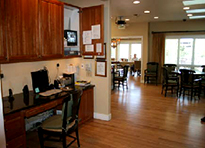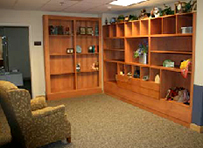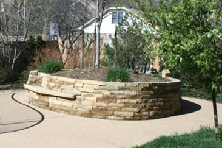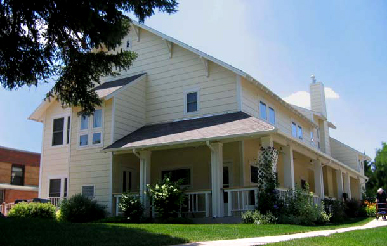People with dementia rely on environmental cues to support them physically, cognitively, and emotionally. Unfamiliar, chaotic, or disorganized environments—whether at home, in adult day care, or in a care facility—are stressful and can cause anxiety, disorientation, and contribute to behavioral problems.
A therapeutic environment provides support for someone with dementia and their family. It recognizes that people with dementia are influenced by their surroundings and do better with environments that are individualized, flexible, and designed to support differing functional levels and approaches to care (Campernel & Brummett, 2010). At a minimum, an organization caring for people with dementia should understand that people with dementia deserve and need kind and supportive care focused on dignity, respect, and autonomy.
Person-Centered Philosophy of Care
Person-centered care depends on a caregiver’s and organization’s skills, training, and knowledge. It means that care is built around both resident and caregiver needs and preferences, creating a high-quality shared environment. Person-centered care is flexible, creative, and supportive. Person-centered care is also referred to as dementia-friendly care, which promotes inclusion of the person living with dementia and their caregivers in care and treatment decisions, with the aim of increasing positive outcomes for both (Handley et al., 2015).
The Physical Environment
There is a connection between the environment and how people feel and behave. Homes or buildings thoughtfully designed for the care of people with dementia encourage community, maximize safety, support caregivers, cue specific behaviors and abilities, and redirect unwanted behaviors (Campernel & Brummett, 2010). Safety, security, simplicity, and familiarity are central principals for the design of dementia-friendly environments. For someone with dementia, a familiar environment is predictable, lessens confusion, and creates a sense of being at home. This supports social relationships, identity, autonomy, and privacy (Førsund et al., 2018).
A dementia-friendly facility should be of a smaller size, with an open design. This is less confusing for someone with dementia and allows staff and caregivers to easily monitor clients at a distance. Although it is important not to overwhelm residents and adult day care participants with too much information or noise, the design should provide useful stimuli such as familiar cues to bathrooms and exits to safe outside areas. Private spaces are important, allowing people to be alone or in close company of a friend (de Boer et al., 2018).
Dementia-friendly indoor design can include:
- Private space in a client’s room with a private bathroom and a separate bedroom or recess for sleeping.
- Public spaces with easy accessibility and places for semi-private interactions.
- Rooms personalized with furniture, memorabilia, pictures, televisions, computers, and personal possessions.
- Control/absence of smelly odors.
- Sunlight, ventilation, and elimination of dark nooks and crannies.
- Small, residential-looking nursing stations.
- Spaces that cue specific behaviors (activity kitchen, art and music therapy area, bistro/bar, rummaging room, library, coffee shop/internet café, quiet room, living room, family visiting area).


Left: Residential-looking, smaller-scaled nurses’ station. Right: a room for rummaging. Source: Campernel & Brummett, 2010. Used with permission.
Dementia-friendly outdoor design can include:
- Spaces that resemble a natural community.
- Continuous circulation routes with looping pathways, plenty of seating, and areas of interest.
- Residents’ inclusion in the design of new features such as walking paths and gardens.
- Safe, purposeful, and accessible outdoor areas.
- Attractive landscaping, gardens, and views to the outside. (Rijnaard et al., 2016)


Left: Safe, looping wandering paths with areas of interest along the way. Right: A memory-care facility with home-like outdoor porch area for seating and reflection. Source: Campernel & Brummett, 2010. Used with permission.
Facilities using dementia-friendly design principles provide real benefits for staff, caregivers, and people with dementia. In a comparison of “regular” specialized care units and small, homelike specialized care units in the Netherlands, residents in the homelike care units needed less support with activities of daily life, were more socially engaged, showed less agitation over time, and needed less psychotropic medication and fewer physical restraints. Residents of the small, homelike units awarded higher scores to aspects of quality of life, showed less negative affect, better social relationships, and were more engaged in activities (Kok et al., 2016).
Although there is a trend toward the development of smaller, home-like nursing homes, large nursing homes are still the norm. In the U.S., there are approximately 16,000 nursing homes with an average of 100 beds per facility. In Florida, nursing homes have the eighth highest number of beds—an average of 120 beds per facility (Harrington &Carrillo, 2018).
Safety and Security
People with dementia need feel safe (and be safe) without the use of physical and chemical restraints. This means managers must create an appropriate environment, encourage safe mobility, and plan for adverse or unplanned events.
The table below illustrates some common safety hazards along with suggestions to help make the environment more safe and secure. Since every situation is different, interventions must be tailored to match the specific circumstances.
|
Safety and Security Issues and Interventions |
||
|---|---|---|
|
Safety issue |
Possible consequence |
Intervention |
|
Wandering |
Getting lost, exposure to environmental hazards, injury |
|
|
Cooking without supervision |
Fire, injury |
|
|
Falls |
Injury, fear of falling, self-restriction of movement |
|
|
Poisoning |
Sickness or death |
|
Simply living in a longterm care facility or receiving care at an adult day care center can be a source of safety and security. Having regular contact with specially trained caregivers can provide comfort, predictability, and a sense of ease (Rijnaard et al., 2016).
Schedules and Routines
In traditional nursing homes, daily life is primarily organized around the routines of the nursing home and the convenience of the staff—schedules can change dramatically from day to day. This is difficult for people with dementia because they rely on a predictable routine for orientation.
Although caregivers and staff are responsible for maintaining a schedule, dementia-friendly facilities encourage caregivers to be flexible and adjust their schedule to benefit the person they are caring for. For example, if someone does not want to take a shower on a usual bathing day, a caregiver might help the person wash up and schedule the shower for another day. People with dementia tend to be slow, so caregivers must allow ample time when preparing for an outing or an appointment. Attempting to rush can cause aggressive behaviors and frustrate both parties.
Staff as Part of the Environment
There are approximately 687 certified nursing homes in Florida. Since 1987, the Nursing Home Reform Act has required nursing facilities to have enough nursing staff to provide nursing and related services to attain or maintain the highest possible physical, mental, and psychosocial well-being of residents. Facilities must have a registered nurse as a Director of Nursing for at least eight consecutive hours a day, seven days a week and licensed nurses on-site twenty-four hours a day (Harrington and Carrillo, 2018).
Staff turnover is one of the most vexing problems for nursing homes and other organizations that provide care for people with dementia. For people with dementia, this lack of consistency and staff turnover make it particularly difficult to keep staff “dementia-trained” and thus integrated into the living environment.
Did You Know. . .
The turnover rate for registered nurses, licensed vocational nurses, and certified nursing assistants is significantly higher in nursing homes than in other healthcare settings. In Florida, from July 2014 to June 2015, the turnover rate for RNs and CNAs was approximately 40%. For LPNs the turnover rate was an eye-popping 100% (FCN, 2016).
Some organizations promote dementia-friendly care by restructuring the relationship of staff to residents. This model deemphasizes the medical model and emphasizes practices that seek to reduce loneliness, helplessness, and boredom. One example of an organization that promotes dementia-friendly care is the Eden Alternative, which focuses on what they call “elder-centered” principles of care. The Eden Alternative stresses the need to address the scourge of loneliness, boredom, helplessness, and loss of meaning. Key principles are:
- Make life worth living by creating a human habitat where life revolves around close and continuing contact with people of all ages and abilities, as well as plants and animals.
- Decrease loneliness by providing easy access to human and animal companionship.
- Address helplessness by creating opportunities to give as well as receive care.
- Address boredom by creating an environment in which unexpected and unpredictable interactions and happenings can take place.
- Develop meaningful activities. Meaningless activity corrodes the human spirit.
- Make medical treatment the servant of genuine human caring, never its master.
- De-emphasize top-down, bureaucratic authority, seeking instead to place the maximum possible decision-making authority into the hands of the Elders or into the hands of those closest to them.
- Make sure human growth is never be separated from human life.
- Develop wise leadership, which is the lifeblood of any struggle against loneliness, helplessness, and boredom. (Kubsch, Tyczkowski, & Passel, 2018)
In an analysis of staffing at several Eden facilities covering a 6-year period from 1999-2005, staff turnover was reduced to approximately 10% per year (even as low as 5% in some facilities), agency staffing was eliminated, and there was a 60% decrease in absenteeism. Other positive outcomes included significant decreases in behavioral incidents, pressure ulcers, and restraint use (Buswell, 2019).
Proper Staffing
Proper staffing in nursing homes and other facilities providing services for older adults with dementia is consistently associated with higher quality of care. In Florida, as in many states, nursing assistants spend more than 3 times as much time with residents in nursing homes as do registered nurses (Harrington & Carrillo, 2018).
Nursing homes with more RN hours per patient have been associated with positive outcomes and fewer deficiencies. The benefits of higher staffing levels, especially RNs, include lower mortality rates; improved physical functioning; less antibiotic use; fewer pressure ulcers, catheterized residents, and urinary tract infections; lower hospitalization rates; and less weight loss and dehydration (Harrington & Carrillo, 2018).
Staff Adjusting to Resident Routines
When a facility is reorganized into a dementia-friendly care home, staff adjust their routines to the routines of the residents, rather than the other way around. This requires a fundamental shift in how medical professionals have been educated and trained.
In a home-like setting, the medical aspects of the facility are deemphasized. Residents, staff, and family caregivers work as a unit. To the extent possible, care team should be consistent. Daily tasks, such as cooking and cleaning, are shared and organized by residents, staff, and caregivers. Not surprisingly, this reduces staff turnover and provides more satisfaction for both staff and residents.
To encourage integration of the staff into a home-like environment:
- Hire staff with the emotional skill, training, and desire to interact with people with memory problems.
- Increase pay, training, and opportunities to advance.
- Eliminate institutional, centralized nursing stations.
- Locate nursing and work areas throughout the building for staff convenience.
- Allow staff to control lighting and environmental levels.
- Emphasize signage for residents, limit signage for staff and visitors.
- De-emphasize or camouflage doors to staff and utility areas.
- Keep staff consistent.
